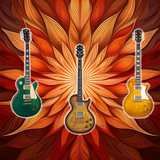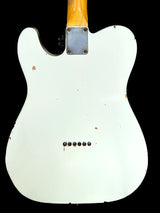Author: Santiago Moto
You’ve been saving your hard-earned pay to buy your first proper guitar. You’ve put hours upon hours of hard work to enjoy your new six-stringer. The day has come and it’s time for you to choose what guitar you want to buy. So, you go online and, suddenly, all your joy turns sour because you’re overwhelmed by the options. Don’t worry; you are in the right place. We will answer the question above and help you choose an instrument you’ll love; one that will accompany you through your learning years. Moreover, if you’re like me, you’ll still have your cheap red Stratocaster-copy 25 years on from today.
Are you ready to choose your next guitar like a boss? Well, buckle up because the ride starts right now.
First Crossroads: Acoustic or Electric?
I’m sure you’ve heard about the difference between electric and acoustic. In case you haven’t: an acoustic guitar generates sounds through the resonance of its hollow body and an electric guitar needs to be amplified… electrically. Are there crossovers between these genres? Of course, and we’ll address them soon.
Yet, this is the first crossroads because acoustics and electrics share ground but have different applications. Indeed, you can’t add distortion to an acoustic without deafening the entire audience with a loud high-pitch feedback noise. Likewise, playing “Tears in Heaven” or “Road Trippin’” on an electric will make these songs lose their magic. Let me help you with some deciding criteria:
Acoustic guitars
PROS:
- they are self-sufficient instruments. This means all you need is the guitar to start playing. Therefore, beginners and those who just like to accompany their voices will find them more suitable.
- they make remarkable tools when you gather with friends to play music. If your idea is to play long afternoons at the park or take the guitar with you everywhere, acoustics fit the bill much better.
CONS:
- Acoustic guitars don’t get along with loud stages and high levels of distortion. If you want to play in a traditional rock, punk, or metal band, your acoustic won’t make it on the stage.
- they aren’t loud instruments unplugged in. Although you can buy acoustic-electric guitars, they aren’t the best choice for loud band environments.
What kind of music can you play on an acoustic guitar?
This is a good question for those deciding between buying an acoustic guitar or an electric guitar. An acoustic guitar is a great songwriting instrument. Moreover, you could easily name at least 20 guitar genres that serve from acoustic guitars only. For example, we can think of folk, fingerpicking, flamenco, and country music, among many others. Yet, acoustic guitars matter the most because they are great instruments to learn and play songs on. Indeed, no other type of guitar can accompany singer-songwriters like an acoustic guitar.
If that is what you aim to do with your instrument, then acoustics are for you.
Acoustics: Nylon or Steel Strings?
Let’s narrow down the scope even further. There are, at least, two types of approaches when playing guitar acoustically: nylon and steel string guitars.
But what’s the difference between them? What can we play with each of them?
Well, the big difference between steel and nylon strings is tension. Indeed, nylon guitars are gentler on the player’s fretting hand fingers. This makes them ideal instruments to take your first steps into guitar learning. On the other hand, most of the songs you want to play and have heard all your life are played on steel-string acoustic guitars. Let me tell you that, although there are similarities, they don’t sound close to each other. Going back to nylon strings, if you’re planning to cover any classic repertoire or take academic music lessons, you have to know that these are the mandatory guitars for that. On the other hand, if you need volume and playing the classics you’ve heard all your life, steel strings is probably a better choice.
This is one thing I learned with time: the relevance of the guitar neck. Regardless of the size of your hands, guitar players always gravitate toward a neck shape and width. Steel string guitars usually feature thinner necks. So, before you buy either of them, make sure you spend at least five minutes playing to get a feel of the neck.
The Never-ending dilemma - Martin vs. Taylor
Martin has been making top-notch acoustic guitars since 1833. If you’ve ever played any of them, you’ll remember that the guitar offers a big tone, heavy in the mids with lots of presence and a big and round low end. If you play a top-shelf model or a Little Martin, the result is always “the Martin tone”.
On the other hand, Taylor was founded in 1974 and represents a new take on acoustic guitar sounds. All of the sudden, the beat became more important and guitars had to fit in a smaller sonic territory. Therefore, that’s what you can expect from a Taylor acoustic: amazing high-end, round harmonic overtones, and transparent mids.
Where am I going with this? Well, Martin and Taylor feature the same build quality and a similar price tag. This makes them a confusing choice. But we’re here to help you, so let’s get to it
Why buy a Martin Acoustic Guitar?
Buy a Martin if you are a solo performer, songwriter, or player in a not-so-crowded ensemble.
Why Buy a Taylor Acoustic Guitar?
Buy a Taylor if you are after a more modern sound or play in a crowded band.
Introducing the Electric Guitar
Well, if you chose electric at the first crossroads, the moment has come for us to talk about your future instrument. Welcome to the electric guitar realm; we’ll talk about loud guitars and lots of fun.
The Do-it-all Models
In the history of guitar playing styles, several guitar models appear in every genre over the past 70 years. This is not a random occurrence or coincidence; these are the true do-it-all guitars.
The Stratocaster
This guitar model is not only the best-selling in guitar history but also one of the most flexible in terms of styles. Indeed, the Stratocaster created rock history in the hands of players like Jimi Hendrix, revolutionized pop music in the hands of Neil Rodgers, and marks the steady pulse of Cory Wong, John Mayer, John Frusciante, and many, many others.
The Stratocaster makes a terrific first guitar because you can play many styles with it. This is a cool Fender video about how one is created.
The TelecasterThe telecaster is not as ductile as the Stratocaster is but it is a songwriter powerhouse. This is certified by the overwhelming success of songwriting kings Keith Richards and Bruce Springsteen, for example. There is something about the simplicity of the instrument that makes it friendly for players in all genres.
So, what does John 5, Jim Root of Slipknot, Deftones' Stephen Carpenter, virtuoso Danny Gatton, the one-of-a-kind Johnny Greenwood of Radiohead, Graham Coxon of Blur, Jason Isbell, Carrie Brownstein, Julien Baker, and Joe Strummer have in common? They play(ed) Telecasters for a living. But don’t just get my word for it, here’s legendary guitar player The Edge from U2 talking about the Telecaster’s role in music history.
The Les PaulFor an even greater palette of sounds, get a strat or tele with a rosewood fretboard. It sounds a little mellower; the high-end of the maple neck might be a game-breaker for some ears.

Although it is mostly associated with rock, the Les Paul guitar can be spotted in all types of music styles. That being said, it is in third place on this list because it is the guitar with the strongest personality of the three. You can translate “personality” into having a tone of its own. The good news is that the Les Paul offers many options through its onboard controls. These sounds can go from clean to distortion and everywhere in between. This is a sample in the expert hands of Mr. Joe Bonamassa.
The Les Paul guitar requires a slightly more difficult construction method that’s called “set neck”. This makes the guitar more expensive than bolt-on necks like in the Stratocaster and the Telecaster. In this cool Gibson video, you can see how it’s made.
Music Genres & Guitars
Apart from the above guitars which are great for playing any genre, we’re going to go more specific and give out some rules of thumb to guide you on your quest.
What are superstrats?Not all strats are not born the same. Indeed, the basis of many guitars might be the Stratocaster, but the ‘80s decade left us with a different, tweaked, modernized, guitar called “Superstrat”. These guitars are rock and heavy-music oriented featuring the smallest necks in the market, humbuckers instead of single coils, active preamp systems, floating tremolos, and more.
If you follow guitar virtuosos Steve Vai, Joe Satriani, John Petrucci, and Guthrie Govan among many others, you’ll see that they push the boundaries of guitar playing with superstrats on their hands. Examples of this kind of guitar can be found in brands like Ibanez, MusicMan, Jackson, Charvel, and Dean among many others.
Hollow and Semi-Hollow Body Instruments
Remember we talked about crossovers between acoustics and electrics? Well, this is it. Hollow and semi-hollow body instruments like the Epiphone Casino and the Gretsch Country Gentleman, the Fender Telecaster Thinline, and the Gibson ES-335 are prone to sound bigger and fuller than solid-body instruments but tend to feedback a lot. This makes them ideal for genres like neo-soul, soul, jazz, blues, and songs that need a huge guitar sound (hello Noel Gallagher) and not so much distortion. That being said, some players like The Cult’s Billy Duffy who plays a Gretsch White Falcon with obnoxious levels of distortion became famous for overcoming that challenge.
Yet, as a rule of thumb, they are not the most suitable for those cases. Examples of brands for these instruments can be Gretsch, Gibson, Epiphone, Eastman, Guild, D’Angelico, PRS, Collings, and B&G.
Guitar Mini Buying Guide
The Electronics & the Wood Type

Electronics alone can tell you much about what a guitar was built for. Some examples can be the type of pickups, tremolo system, and controls. Arguably, the electronics are the parts of the guitar that affect the tone the most.
For example, if you install a set of active EMG pickups on an old Fender Telecaster it will sound closer to Jim Root than to Bob Dylan. So, as a rule of thumb, what you can think is that single-coils and P-90s are clean-sounding with treble and edge. On the other hand, humbuckers sound big and deliver more low-end.
In the same vein, wood types like ash, swamp ash, maple, pine, and spruce tend to be brighter than mahogany, basswood, and rosewood. So, don’t be shy and ask the vendor all these questions. This information alone will get you much closer to knowing if the guitar is what you’re looking for even before playing it. Speaking of which…
Sound, Neck, Playability, and Then Looks
Sound is king. That is the most essential piece of advice anyone can give you about finding the right guitar for you. First and foremost, you have to like the way the guitar sounds. Next, you need to like its neck. Does it feel comfortable? Is it too wide or too narrow? Remember, there’s little to be done to fix a neck you don’t like once you bought the guitar. So, feel the neck for at least some minutes before making a decision. This will affect playability, which is customizable, but also super important because nothing hurts more than badly-finished frets and a guitar going constantly out of tune. Finally, you have to find it attractive enough to want to play it every day.
The Good Ole’ Guitar-Brands-For-Style RundownAlthough how the guitar is played affects the sound more than the build and the electronics, some brands and guitar models are friendlier to some styles.
- Gibson – Gibson guitars tend to work better for rock, jazz, blues, and heavy metal. This is because most feature mahogany bodies and necks, and humbucker pickups. Gibson acoustic guitars sound big and full with a record-like quality.
- Fender – Fender’s guitar lines cover all genres from heavy metal to hillbilly. That being said, classic models shine in styles like funk, blues, country, alternative music, and folk. Their acoustic range covers entry-level models to mid-priced acoustics.
- PRS – Perhaps, the third biggest guitar company in the world, PRS made a name for itself for being the exact amalgamation of a Stratocaster and a Les Paul. Indeed, most of Paul’s guitars have a Stratocaster-shaped body made of mahogany with a maple top like a Les Paul. Furthermore, the scale is 24 ¾” in Gibson and 25 ½” in Fender; for PRS it’s 25”.
- Tom Anderson, Suhr, Pensa - These high-end brands are known for having redefined the quality of superstrats and teles. They have taken classic designs to a different level moving away from heavy music and closer to Hi-Fi territory. So, if your guitar playing techniques list includes super clean, fast rhythmic patterns these are the brands to look at. Furthermore, they work amazingly for super clean, compressed, detailed, and fast playing in styles like funk, virtuoso territory, rock, and pop.
Conclusion
By now I hope you have a clearer idea of what you want when you go to buy your next guitar. We’ve gone through the models and the brands and even threw in the mini buying guide. But we didn’t just leave it there; we also added the controversial “The Good Ole’ Guitar-Brands-For-Style Rundown” so you get a better idea of brands and guitars to choose from.
Now, it’s all up to you. How many songs will your new guitar bring to you? Pick the right one and be inspired to write new and amazing music. Happy (new) guitar playing!



